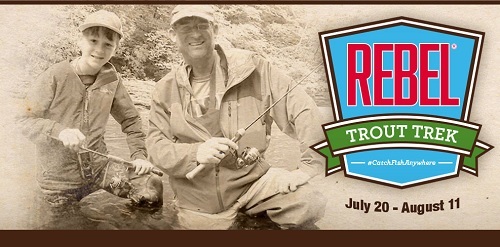 If you look at a real bluegill or any closely related sunfish, you’ll see that it isn’t shaped like a typical crankbait. Now look at a Rebel Bluegill. From the sides, the body is deep, except toward the tail end – just like a real bluegill. From the front, back, top or bottom it’s flat and narrow – just like a real bluegill. The profile, like the color patterns, matches what this lure was designed to imitate from every angle.
If you look at a real bluegill or any closely related sunfish, you’ll see that it isn’t shaped like a typical crankbait. Now look at a Rebel Bluegill. From the sides, the body is deep, except toward the tail end – just like a real bluegill. From the front, back, top or bottom it’s flat and narrow – just like a real bluegill. The profile, like the color patterns, matches what this lure was designed to imitate from every angle.
That’s a very good thing, because bass, pike and other predator species eat a lot of bluegills.
A Rebel Bluegill is a shallow-diving crankbait with a moderate wobble that offers “cast, crank and catch” simplicity. While you can present this 2 1/2-inch crankbait various ways, you’ll catch a lot of fish by simply casting it, cranking it back and remaining ready. In fact, that’s the best presentation on many days.
Beyond being simple to use, a Bluegill comes with barbless treble hooks, which makes it much safer than most crankbaits and a really good lure to tie on for young anglers. As long as you keep the line tight, you’ll likely be surprised by how few fish you lose on barbless hooks, and you’ll be delighted by how easy it is to unhook fish after you do land them.
Because of the species a Rebel Bluegill best imitates and because its normal running depth is about 3 feet, the Bluegill generally works best in relatively shallow water and around cover, which could be anything from weeds to docks, to riprap to stumps.
The lure’s square diving lip deflects cover well, so don’t be shy about fishing it tight to cover. Deflecting cover or kicking the lure off the bottom often prompts strikes from fish that are following a lure or watching from an ambush position, so hitting as much stuff as possible generally is a good strategy. And because a Bluegill only runs a few feet deep, when you do get snagged, it’s usually not hard to get the lure back.
A Rebel Bluegill can be fished on spinning or baitcasting tackle. A medium action rod and line in the 8- to 14-pound test range works well for most situations. Lighter line allows for the freest action and is good for open water. The heavier end of the range keeps the bait extra shallow and provides added muscle for getting fish out of cover.

